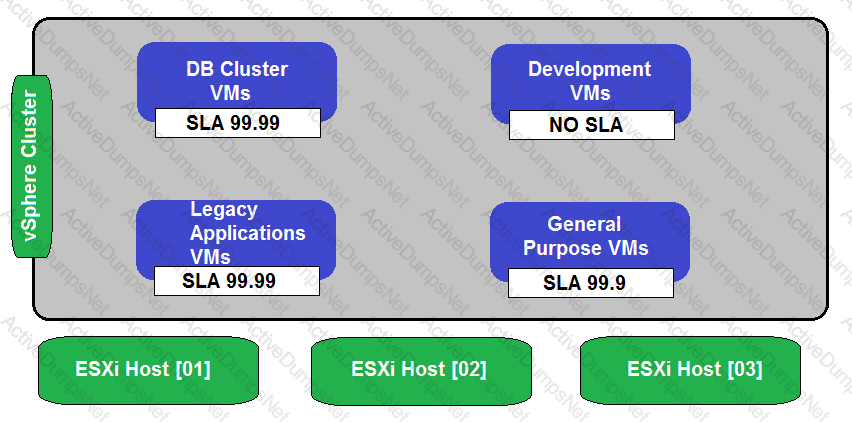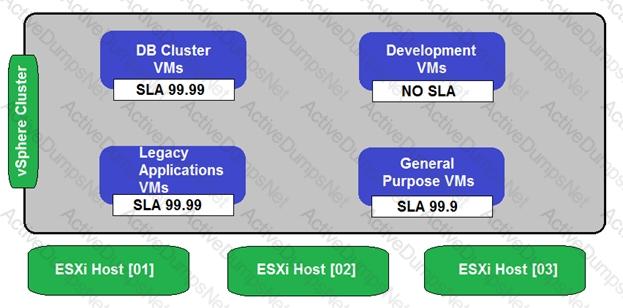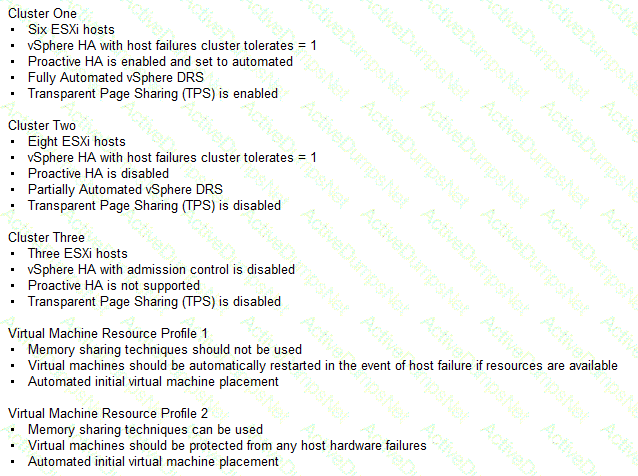VMware 3V0-21.21 Advanced Design VMware vSphere 7.x Exam Practice Test
Advanced Design VMware vSphere 7.x Questions and Answers
Refer to the exhibit.
During a requirements gathering workshop, the customer shares the following diagram regarding their availability service-level agreements (SLAs):

The customer wants database application level availability to always take precedence. What should the architect recommend to meet the customer’s requirement?
Which of the listed requirements would be classified as a recoverability non-functional requirement?
An architect has 50 ESXi hosts to deploy and DHCP servers are not allowed on any network. Which automated host deployment method should the architect use?
A new vSphere platform is being created. The platform will host virtual machines that will run management services and line-of-business applications.
What should the architect consider when designing the number and type of clusters required?
An architect is finalizing the design for a new vSphere platform based on the following information:
- All Windows virtual machines will be hosted on a dedicated cluster for licensing purposes.
- All Linux virtual machines will be hosted on a dedicated cluster for licensing purposes. All management virtual machines will be hosted on a dedicated cluster.
- A total of ten physical sites will be used to host virtual machines.
- In the event of one physical datacenter becoming unavailable, the manageability of the virtual infrastructure in the remaining data centers should not be impacted.
- Access to configure the management virtual machines via vCenter Server must be controlled through the management Active Directory domain.
- Access to configure the Windows and Linux virtual machines must be controlled through the resource Active Directory domain.
- The management and resource Active Directory domains are part of separate Active Directory forests and do not have any trusts between them.
- The design will use Active Directory with Integrated Windows Authentication.
How should the architect document the vCenter Server configuration for this design?
An architect is designing a solution based on the following information:
- Each ESXi host has a single physical NIC with two 10 Gbps ports.
- There is a performance-based service-level agreement (SLA) that guarantees 15 Gbps bandwidth for production virtual machines at all times.
- There is no budget to purchase additional hardware.
- The hardware replacement SLA is based on a delivery agreement of two business days.
Which recommendation for the configuration of vSphere High Availability (HA) should the architect include in the design?
The Chief Information Security Officer (CISO) for an organization is concerned about the security posture of the operating system images that are used for the provisioning of their Software-as-a-Service (SaaS) applications. The organization is in a growth period. The organization is opening a new data center to launch its next phase of new SaaS-based solutions.
The DevOps team currently creates encrypted virtual machine (VM) templates that are used for various operating systems and adds these to the vSphere inventory. The DevOps team already uses a published content library and has been granted a role with the ability to add and delete library items.
The following requirements have been noted:
- Impacts to the DevOps team’s operational processes must be kept to a minimum.
- The DevOps team must be able to regularly check out a copy of the image for updates and check in a new version of the image.
- Images must be synchronized from the primary data center to the new data center.
Which three recommendations should the architect make to design a content library solution that will meet these requirements? (Choose three.)
During a requirements gathering workshop, the customer provides the following requirement that is pertinent to the design of a new vSphere environment:
- The Maximum Tolerable Downtime (MTD) for all Tier 1 applications is one hour.
Which requirement classification is being gathered for the design documentation?
An architect is tasked with recommending a solution for a company that is running out of VLANs. Currently the company is running two separate data centers based on vSphere including an Enterprise Plus license. In the first data center, the problem was solved by using VMware NSX and overlay network. In the second data center, there is currently no VMware NSX implementation in place and no budget for additional licenses.
What should the architect recommend as a potential solution to provide support for additional VLANs?
As part of a requirements gathering workshop, the customer provides the following requirements for the design of a new greenfield virtual infrastructure:
- Some applications have a latency that must be less than 5 minutes.
- The solution must be able to support a workload growth rate of 10% per year.
Which requirement classification is being gathered for the design documentation?
Following a recent acquisition, an architect needs to merge IT assets into its current data center. The combined vSphere environment will need to run the newly acquired company’s virtual machines.
Network integration work has already been completed and the current environment has capacity to host all virtual machines. The Operations team needs to identify which virtual machines belong to the acquired company and report on their usage.
How should the architect merge the company’s assets and virtual machines?
During a requirements gathering workshop, the customer provides the following requirement:
- A new vSphere platform must be designed securely and all interfaces must be protected against potential snooping.
How should this non-functional security requirement be documented?
An architect is designing an environment for a retail customer. The design will use a single small vCenter Server Appliance and a cluster of eight ESXi hosts at a remote site. There is a single 10 GbE connected network at the remote site to support all management services. It is not possible to create additional management networks at the remote site. Virtual machine backups at the site will be dependent on the vCenter Server being available.
Which design decision should the architect make to maximize availability for backups?
The storage team at an organization is planning to migrate from an older Fibre Channel storage environment to a new environment using IP-based storage.
Which two switch features or characteristics are appropriate for IP storage networks? (Choose two.)
Refer to the exhibit.
During a requirements gathering workshop, a customer shares the following diagram regarding their availability service-level agreements (SLAs):

The customer states that there is no application level availability for legacy applications.
Which recommendation could the architect make to meet the customer’s high availability requirements for the legacy applications virtual machines?
An architect is planning the physical server configuration for a vSAN-based infrastructure.
Which operations mode should a RAID controller support to minimize potential server downtime during physical disk failures?
A customer defines a requirement to minimize the vMotion migration time during a maintenance period. The servers being used are equipped with eight 1 GbE network adapters.
Per the defined logical network configuration, there are two network adapters each used for:
- Management traffic
- vMotion traffic
- iSCSI traffic
- Virtual machine traffic
Which design decision should the architect make to meet the customer requirement?
Which requirement would be classified as a functional requirement within the application design documentation?
During a requirements gathering workshop, the customer provides the following information:
- Each host has 2 × 10 GbE NIC
- EtherChannel is not currently configured
- No changes can be made to the physical network
- Network throughput must be prioritized for defined critical services
Which two recommendations should the architect make with regard to virtual networking? (Choose two.)
During a requirements gathering workshop, the customer provides the following requirement (REQ) and constraints (CON):
- REQ01: The customer is looking for a way to limit database virtual machine (VM) placement to save on CPU licensing costs.
- CON01: There is a single cluster with no budget to scale.
- CON02: All virtual machines must run on the consolidated cluster.
Which two design decisions should the architect make to meet the customer requirement? (Choose two.)
During a requirements gathering workshop, the customer’s Chief Information Security Office (CISO) provides the following requirements that are pertinent to the design of a new vSphere environment:
- All operating system critical patches must be installed within 24 hours of release.
- All virtual machine templates must be updated every three months in line with company policy.
Which requirement classification is being gathered for the design documentation?
An architect is considering placement of virtual machines within an existing VMware software-defined data center (SDDC).
During the discovery phase, the following information is documented:

Which two recommendations should the architect make for placement of the virtual machines to meet resource profile requirements? (Choose two.)
A customer has a database cluster with 40/60 read/write ratio and a high IOPs requirement with no contention on an all-flash vSAN cluster.
Which two storage settings should be configured for best performance? (Choose two.)
Which two statements are true about gathering functional business and application requirements? (Choose two.)
An architect is designing a new vSphere platform to meet a list of requirements from the security team.
Which two requirements would be classified as non-functional requirements? (Choose two.)
An architect is preparing a design for a customer. Based on requirements, the architect recommends an HCI- based infrastructure with all-flash architecture. During the assessment, it is confirmed that the network throughput generated by virtual machines does not exceed 150 Mb/s.
What is the minimum number and type of network adapters in each server that the architect can recommend to ensure requirements are met and there is no single point of failure?
